Instructions Manual

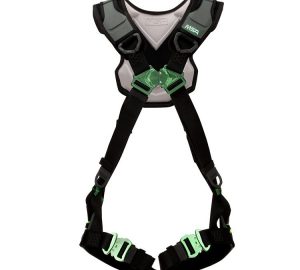
MSA V-EDGE Personal Fall Limiter (PFL)
Twin Use illustrated

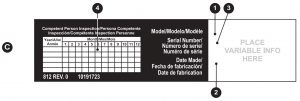
Product Labels



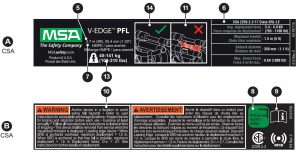
Table 1 – System Requirement
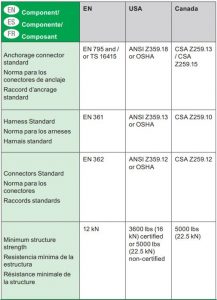
Figure 1 – Load indicator
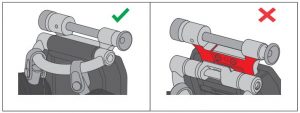
* Meets OSHA 1910.140 requirements when used overhead.** The clearance provided is for the user working in a standing position. If the User is kneeling or bending down, an additional 3’ (.9m) of clearance is required. If the V-EDGE PFL TIEBACK is tied around a structural member that has been suitably identified by a qualified person1 the fall clearance may be reduced by an amount equal to the circumference of the object, up to 3’ (0.9m).
Table 2 – Pre-use checks and periodic examination
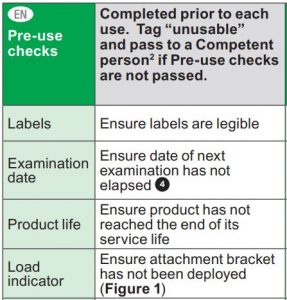
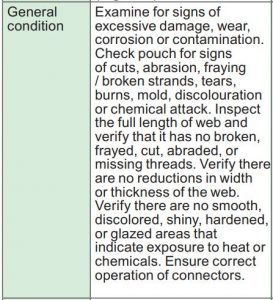
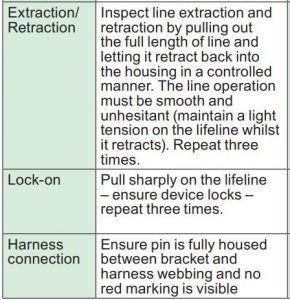
Table 3 – Materials
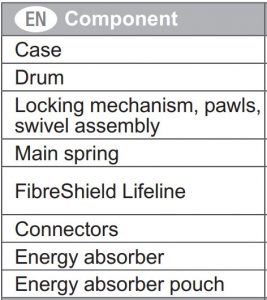
Table 4 – Acceptable anchor locations – Vertical and horizontal use and fall clearance**
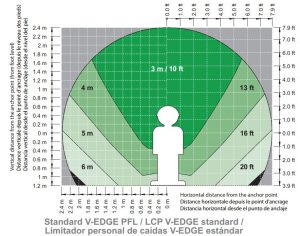
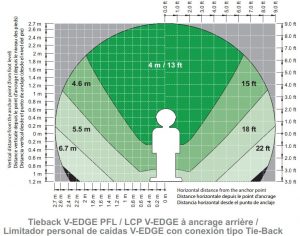
Table 5 – Acceptable anchor locations – Horizontal use with edge consideration
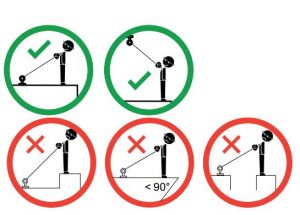
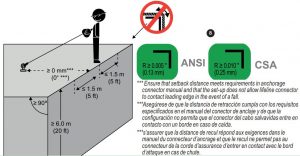
Table 6 Product Marking
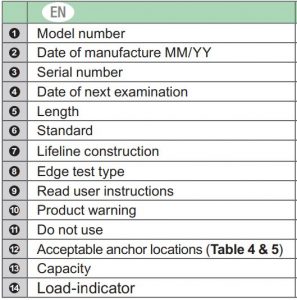
1. General information
Users of V-EDGE PFLs shall be medically fit and suitably trained. V-EDGE PFLs shall not be used by pregnant women, minors or those under the influence of alcohol or drugs.
Instructions shall be retained and provided to all Users of V-EDGE PFLs in the language of the destination country, even when resold. Failure to follow these instructions may adversely affect the functionality of the product, resulting in serious injury or death.
It is recommended that V-EDGE PFLs are a personal issue item.
A declaration of conformity may be downloaded from this product’s page on MSAsafety.com by clicking on the Literature tab.
Warranty detailsFull terms and conditions can be found at on this product’s page on MSAsafety.com by clicking on the Literature tab.
2. Intended use and product limitations
V-EDGE PFLs are intended to be used as a connecting element between a full body harness and anchor point (see Table 1 for system requirements). A full body harness is the only acceptable body holding device to be used with V-EDGE PFLs. If supplied as part of a complete system, components shall not be substituted. The V-EDGE PFL is only to be used for its intended purpose and within its limitations. Further clarification can be obtained from MSA.
For use in accordance with acceptable locations (Table 4 or 5 (nonedge and edge))
- For Single User only, including tools, within the weight range 60-140kg (130-310lbs) for ANSI or 45-140kg (100-310lbs) for CSA.
- The V-EDGE PFL shall be protected from fire, acids, caustic solutions or temperatures outside the range -40°C to 54°C (-40°F to 130°F)
- The lifeline shall not come into contact with hot surfaces (such as hot pipes), become entangled with moving machinery, or contact with electrical hazards (such as power lines)
- Unsuitable for use on unstable surfaces, fine grain materials or particulate surfaces such as sand or coal, as insufficient speed may prevent lock-on in the event of a fall
- Additional lanyard connectors shall not be added, as this would serve to lengthen the lifeline and increase freefall
See Warning Supplement (PN 10193199) for additional considerations.
3. Installation and use
![]() WARNING
WARNING
Only PFLs labeled “TIEBACK” may be used in a tie-back configuration. Failure to follow this warning can result in serious personal injury or death.
A written rescue plan and the means to implement it shall be in place to deal with emergencies that may arise during use.
The V-EDGE PFL shall be attached only using the harness connector bracket to the harness webbing (see Fitting instructions). Do not attach additional connectors between the bracket and harness, attempt to bypass the connecting bracket or connect directly to the V-EDGE PFL mechanism.
Ensure both V-EDGE PFL connectors are compatible with the attachments to which they are connected (to prevent roll-out), and are fully closed and locked before use. See Table 1 for system requirements.
Ensure the V-EDGE PFL is attached to compatible anchors – flexible anchors, such as anchor lines or cantilever structures can affect the ability of the V-EDGE PFL to lock on in the event of a fall. For further clarification, contact
MSA. When selecting an appropriate anchorage, follow all instructions provided with anchorage connector.
In use, the V-EDGE PFL lifeline will extract and retract without hesitation. Do not allow the lifeline to pass through legs or under arms, or wrap around structures. If the lifeline does not retract in use, fully extract the lifeline and slowly allow it to retract. If the lifeline continues to hesitate in retraction, contact MSA.
The V-EDGE PFL twin-leg configuration is intended to give users 100% tie-off when moving around the work site. One of the legs must be attached to an appropriate anchorage connector while the user moves to the new location. At the new location, attach the second leg to an appropriate anchorage connector before disconnecting the original leg. Repeat this process until the final destination has been reached.
When using the V-EDGE Twin PFL in a horizontal application the horizontal distance apart shall be ≤ 2 m (6.5 ft). Large horizontal spans shall be avoided, as they can increase forces applied to the structure and introduce unpredictable swing falls.
The V-EDGE TIEBACK configuration is intended to give users the ability to anchor directly to structural members that have been suitably identified by a qualified person1. To use wrap the leg of the PFL around the identified structural member and connect the FP5K snaphook to the leg to create a closed loop. Be sure the snaphook gate is completely closed, locked, and captures the leg of the lanyard. Inspect anchorage to assure the tie-back loop on the leg of the PFL cannot be accidentally disengaged from the anchorage during use.
4. Leading edge use
Leading Edge Use: The V-EDGE PFL has been tested for horizontal (Leading Edge) use over a steel edge without burrs using the methods in ANSI Z359.14- 2014 (type SRL-LE) and CSA Z259.2.2-2017 (Class SRL-LE). Therefore the V-EDGE PFL may be used where a fall may occur over similar edges. Leading Edge configurations shall only be used after all other hierarchy of controls, including restraint systems and overhead anchorages, have been exhausted.
Prior to use, leading edges must be evaluated by a qualified person. Avoid working where the lifeline will continuously or repeatedly abrade against sharp, hard, or abrasive edges. If the risk assessment indicates that an edge could damage the lifeline then eliminate such contact or protect the edges using a pad or other means before the start of work.
Horizontal use or anchoring at the feet of the User should be limited wherever possible to avoid the potential for swing fall and the possibility of the User striking a structure, potentially causing serious injury. To reduce the risk of a swing fall, it is preferable to anchor directly above the User.
Anchor locations shall adhere to Table 5, including a redirection angle ≥ 90º and set back ≥ 0 mm*** (0 ft***); ensuring the correct function of the device in the event of a fall. Lateral movements to both sides of the centre axis shall be limited to a maximum of 1.5 m (5 ft) as shown. The V-EDGE PFL anchorage point shall be at the User’s foot level or above. Climbing above the anchorage point is not permitted. (See Table 5) Measures shall be taken to prevent use over unintended edges (such as on the opposite side of the anchorage or around corners).
If a fall over an edge is possible, special rescue measures shall be defined and trained. Consideration shall be given to accessing a suspended user without further loading or moving the lifeline over an edge.
5. Fall clearance
Ensure sufficient clearance exists to prevent striking an obstacle or structure during a fall. Insufficient clearance or obstructions can prevent the function of the V-EDGE PFL.
Consult Table 4 (Vertical and horizontal use) or Table 5 (Horizontal use with edge consideration) for acceptable anchor locations in relation to the User and for minimum clearance requirements. Fall clearance is calculated as the vertical distance between the working platform and the first obstacle below (such as the next platform or ground).
The clearance requirements indicated on the graph in Table 4 are based on freefall conditions. The presence of obstructions (such as structure edges) may reduce clearance requirements, but may introduce additional hazards, such as potential for laceration or impact injuries. Additional clearances may be required to account for the effects of a swing fall.
Only attach the V-EDGE PFL to an anchor that may deflect or deploy in a fall, such as a dead weight anchor or anchor line, where there is no risk of the line contacting an edge. In such cases, the additional deployment of the anchor shall be added to the minimum clearances specified in Table 4 (non-edge).
To reduce the potential for injury in a fall, the fall distance should be minimized For CSA users, Deployment is equal to [D(141) = 0.7] times [free fall distance, in m] for a maximum worker mass [in kg] or deployment based on the results of the dynamic performance testing specified in Clause 7.2 of the relevant CSA standard, whichever is greater.
6. Cleaning, maintenance and storage
If required, the V-EDGE PFL exterior and lifeline may be cleaned using a damp cloth and warm water (max. 40°C), and allowed to dry naturally before use. Excessive build-up of dirt, paint etc. may compromise both retraction and strength of the lifeline.
Store or transport the V-EDGE PFL in a cool, dry, clean environment, away from dust, oil and direct sunlight. During transportation, the device shall be protected to prevent damage or contamination. Examine the V-EDGE PFL after long periods of storage prior to returning it to service.
When not in use, store with the lifeline fully retracted as prolonged periods of full extraction may weaken the retraction spring. If the lifeline is released, it will retract at high speed, potentially damaging internal parts and / or causing kinks in the lifeline.
Moving parts of snaphooks, carabiners, and the attachment bracket may require periodic lubrication with low viscosity penetrating oil. Follow lubricant manufacturer’s instructions. Do not over-lubricate. Wipe excess with a clean, dry cloth.
7. Pre-use checks and periodic examination (Table 2)
The safety of the User relies upon the continued efficiency and durability of the equipment, therefore Pre-use checks shall be completed before each use. Periodic examinations shall be completed by a person, other than the User, competent2 in the examination of V-EDGE PFLs, in accordance with MSA instructions for periodic examination. The interval will be dictated by the usage (Table 7), local regulations or environmental conditions, and shall be at least annually.
Records shall be kept of the results of the examination. An example periodic examination log can be downloaded from this product’s page on MSAsafety.com by clicking on the Literature tab.
Table 7 Periodic examination interval

The V-EDGE PFL is not repairable. The V-EDGE PFL shall not be altered or added to. If the V-EDGE PFL has be subject to a fall, is unable to pass inspection, an issue has been identified, or any doubt exists as to the suitability of the V-EDGE PFL it shall be tagged“UNUSABLE” and disposed of in accordance with local regulations
Maximum product life:Continued use is dependent upon passing pre-use checks and periodic examinations. Service life may be reduced by frequency and conditions of use or local regulations.
1. Qualified Person: A person with a recognized degree or professional certificate and with extensive knowledge, training and experience in the fall protection and rescue field who is capable of designing, analyzing, evaluating and specifying fall protection and rescue systems.2. Competent person: a person, other than the User, competent in the examination of PPE inaccordance with MSA instructions.
MSA V-EDGE Personal Fall Limiter (PFL) Instructions Manual – MSA V-EDGE Personal Fall Limiter (PFL) Instructions Manual –
Questions about your Manual? Post in the comments!
[xyz-ips snippet=”download-snippet”]

